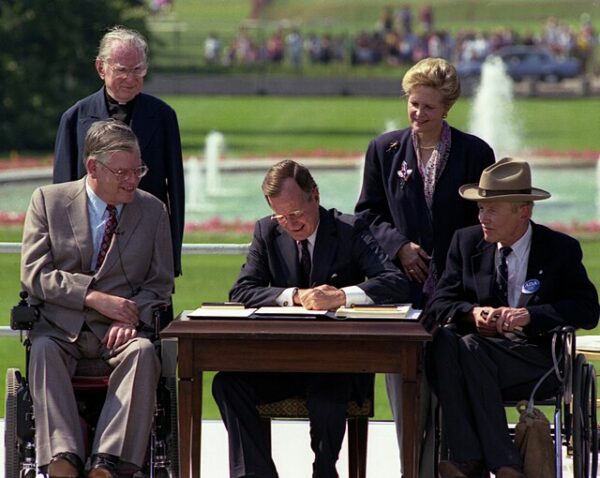In a landmark moment for civil rights in the United States, President George H. W. Bush signed the Americans with Disabilities Act (ADA) into law on July 25, 1990, heralding a new era of legal protection and inclusion for millions of Americans with physical and mental impairments. The legislation, one of the most expansive disability rights laws in the world, represented a sweeping bipartisan effort to enshrine accessibility, dignity, and full participation in public life as guaranteed rights.
Modeled in spirit and scope after the Civil Rights Act of 1964, the ADA sought to eliminate discrimination against individuals with disabilities in employment, public accommodations, transportation, telecommunications, and government services. Its passage marked the culmination of decades of activism by disability rights advocates who had long argued that barriers to access were not inevitable consequences of disability, but of society’s failure to accommodate difference.
Standing before a crowd on the South Lawn of the White House that included wheelchair users, interpreters for the deaf, and veterans of countless protests, President Bush declared, “Let the shameful wall of exclusion finally come tumbling down.” He characterized the ADA as a “declaration of equality” for those who had for too long been excluded from the American mainstream.
The legislation’s practical impacts were immediate and far-reaching. Title I required employers with 15 or more employees to provide reasonable accommodations for qualified individuals and prohibited discrimination in hiring, advancement, or dismissal. Title II mandated that all public services—regardless of whether they received federal funding—must be accessible to persons with disabilities. Title III extended this mandate to privately operated public accommodations such as restaurants, hotels, theaters, and retail stores, effectively ushering in a new architectural paradigm defined by curb cuts, ramps, widened doorways, and accessible restrooms. Titles IV and V addressed telecommunications access and legal remedies.
Although the ADA passed with overwhelming support, it was not without controversy. Business groups initially expressed concern about compliance costs and potential litigation. Some feared that overly broad definitions of “disability” might create ambiguity or burden small employers. Yet, through painstaking negotiation, lawmakers—including Senators Tom Harkin, Ted Kennedy, Bob Dole, and Orrin Hatch—crafted language that garnered broad consensus while still upholding the bill’s core promise: equality through accessibility.
The bill’s signing was deeply personal for Senator Harkin, who delivered part of his floor speech in American Sign Language for his deaf brother. Likewise, Senator Dole, a decorated World War II veteran who had lost the use of his right arm, spoke often about the barriers he encountered navigating the Capitol and everyday life. Their efforts bridged partisan divides and grounded the law’s abstract ideals in lived experience.
The ADA was also shaped by grassroots activism. Groups like ADAPT, the National Council on Independent Living, and the Disability Rights Education and Defense Fund had long staged protests, organized sit-ins, and demanded federal action. Perhaps most famously, in March 1990—just months before the ADA’s passage—dozens of activists abandoned their wheelchairs and crawled up the steps of the U.S. Capitol in a dramatic demonstration known as the “Capitol Crawl,” a visceral rejection of inaccessibility and invisibility.
Over the decades since its passage, the ADA has transformed American infrastructure, workplace norms, and public awareness. Its legacy is not merely physical—etched in elevators and Braille signage—but philosophical, affirming that disability is not a defect to be fixed but a natural part of human diversity deserving of dignity, rights, and recognition.
As President Bush concluded on that summer day in 1990: “With today’s signing of the landmark Americans with Disabilities Act, every man, woman, and child with a disability can now pass through once-closed doors into a bright new era of equality, independence, and freedom.”






